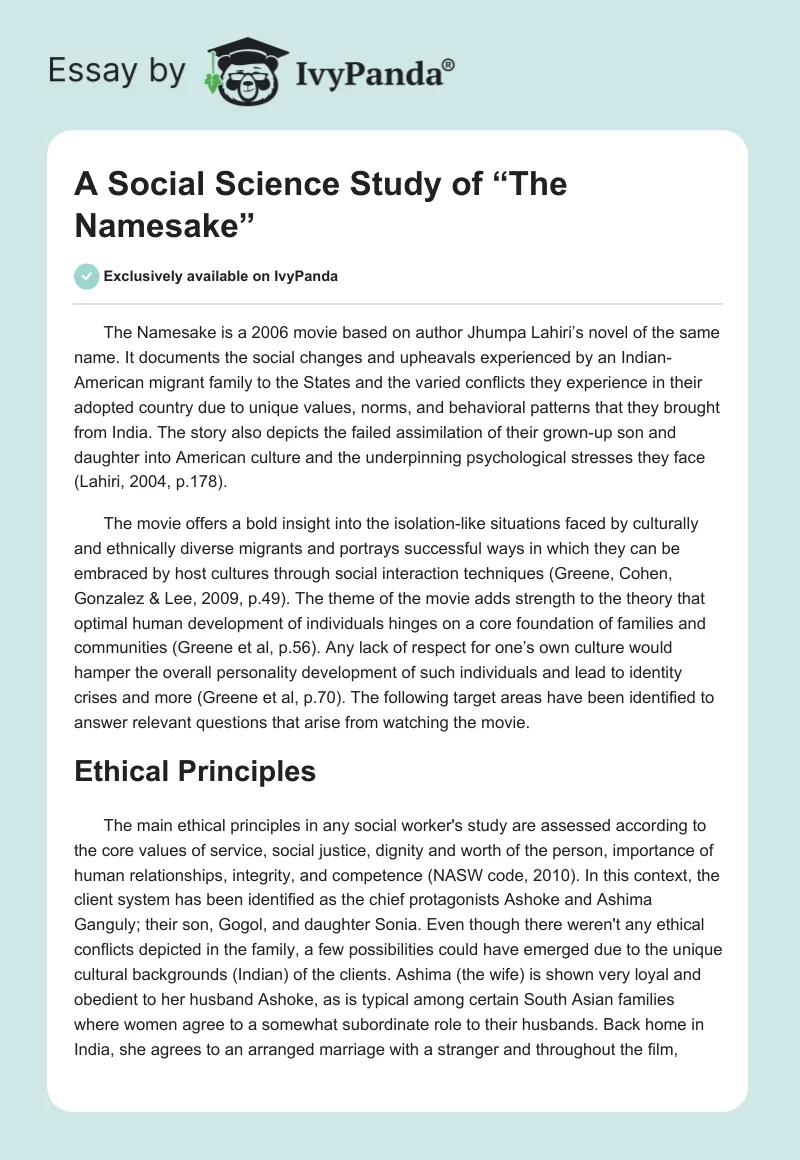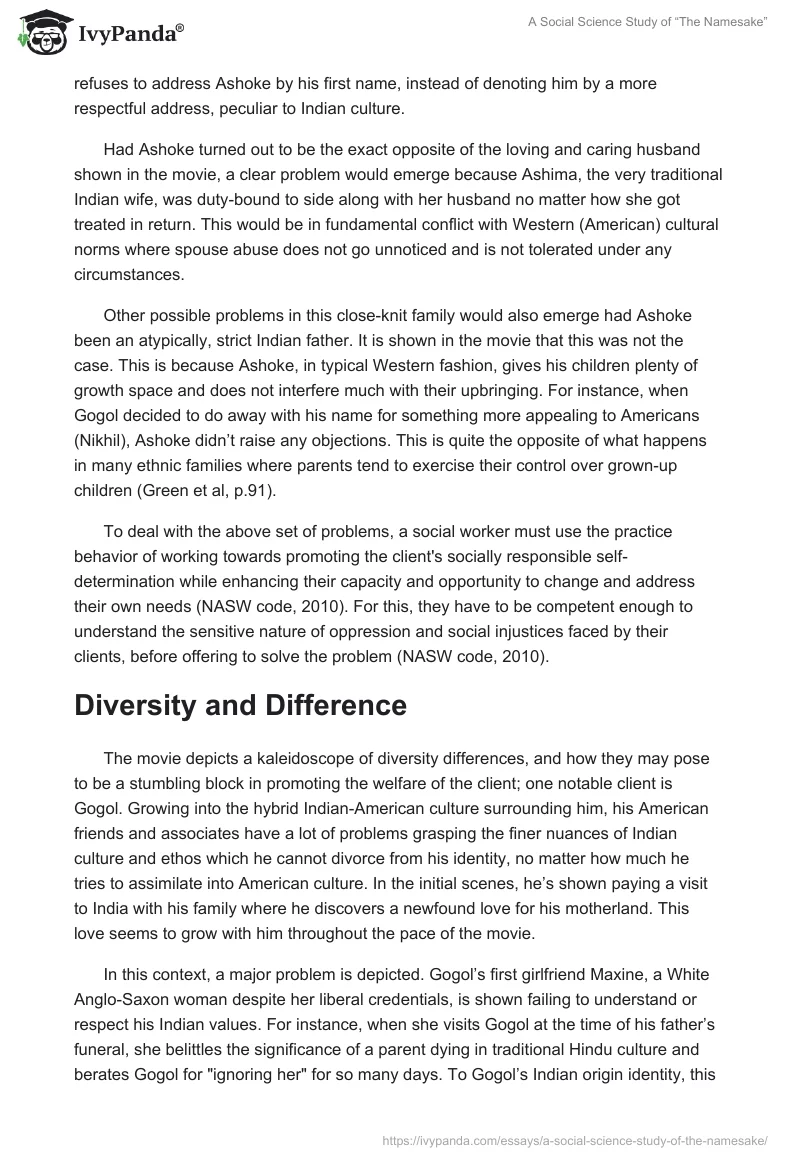The Namesake is a 2006 movie based on author Jhumpa Lahiri’s novel of the same name. It documents the social changes and upheavals experienced by an Indian-American migrant family to the States and the varied conflicts they experience in their adopted country due to unique values, norms, and behavioral patterns that they brought from India. The story also depicts the failed assimilation of their grown-up son and daughter into American culture and the underpinning psychological stresses they face (Lahiri, 2004, p.178).
The movie offers a bold insight into the isolation-like situations faced by culturally and ethnically diverse migrants and portrays successful ways in which they can be embraced by host cultures through social interaction techniques (Greene, Cohen, Gonzalez & Lee, 2009, p.49). The theme of the movie adds strength to the theory that optimal human development of individuals hinges on a core foundation of families and communities (Greene et al, p.56). Any lack of respect for one’s own culture would hamper the overall personality development of such individuals and lead to identity crises and more (Greene et al, p.70). The following target areas have been identified to answer relevant questions that arise from watching the movie.
Ethical Principles
The main ethical principles in any social worker’s study are assessed according to the core values of service, social justice, dignity and worth of the person, importance of human relationships, integrity, and competence (NASW code, 2010). In this context, the client system has been identified as the chief protagonists Ashoke and Ashima Ganguly; their son, Gogol, and daughter Sonia. Even though there weren’t any ethical conflicts depicted in the family, a few possibilities could have emerged due to the unique cultural backgrounds (Indian) of the clients. Ashima (the wife) is shown very loyal and obedient to her husband Ashoke, as is typical among certain South Asian families where women agree to a somewhat subordinate role to their husbands. Back home in India, she agrees to an arranged marriage with a stranger and throughout the film, refuses to address Ashoke by his first name, instead of denoting him by a more respectful address, peculiar to Indian culture.
Had Ashoke turned out to be the exact opposite of the loving and caring husband shown in the movie, a clear problem would emerge because Ashima, the very traditional Indian wife, was duty-bound to side along with her husband no matter how she got treated in return. This would be in fundamental conflict with Western (American) cultural norms where spouse abuse does not go unnoticed and is not tolerated under any circumstances.
Other possible problems in this close-knit family would also emerge had Ashoke been an atypically, strict Indian father. It is shown in the movie that this was not the case. This is because Ashoke, in typical Western fashion, gives his children plenty of growth space and does not interfere much with their upbringing. For instance, when Gogol decided to do away with his name for something more appealing to Americans (Nikhil), Ashoke didn’t raise any objections. This is quite the opposite of what happens in many ethnic families where parents tend to exercise their control over grown-up children (Green et al, p.91).
To deal with the above set of problems, a social worker must use the practice behavior of working towards promoting the client’s socially responsible self-determination while enhancing their capacity and opportunity to change and address their own needs (NASW code, 2010). For this, they have to be competent enough to understand the sensitive nature of oppression and social injustices faced by their clients, before offering to solve the problem (NASW code, 2010).
Diversity and Difference
The movie depicts a kaleidoscope of diversity differences, and how they may pose to be a stumbling block in promoting the welfare of the client; one notable client is Gogol. Growing into the hybrid Indian-American culture surrounding him, his American friends and associates have a lot of problems grasping the finer nuances of Indian culture and ethos which he cannot divorce from his identity, no matter how much he tries to assimilate into American culture. In the initial scenes, he’s shown paying a visit to India with his family where he discovers a newfound love for his motherland. This love seems to grow with him throughout the pace of the movie.
In this context, a major problem is depicted. Gogol’s first girlfriend Maxine, a White Anglo-Saxon woman despite her liberal credentials, is shown failing to understand or respect his Indian values. For instance, when she visits Gogol at the time of his father’s funeral, she belittles the significance of a parent dying in traditional Hindu culture and berates Gogol for “ignoring her” for so many days. To Gogol’s Indian origin identity, this was a fundamental assault. He soon realizes that Maxine, being a Westerner, lacks the sensitivity and empathy required to deal with an Indian family. This becomes the reason for their break-up.
For a social worker, problems related to diversity differences, as shown above, can be solved by recognizing the central importance of human relationships (NASW code, 2010). They should have enough competence to engage people as partners in the helping process and strengthen relationships among people by understanding their unique cultural values and using that knowledge to enhance their well-being (NASW code, 2010).
Human Rights and Social-Economic Justice
Human rights and social-economic justice cannot be one of the key elements in the Namesake since it deals with the subject of problems faced by newly arrived, well-educated immigrants in the States, that too in liberal New York City. NYC is shown as having far greater tolerance and acceptance for ethnic minorities, and their way of life. However in an imaginary scenario, since, the events depicted in the movie are traced from around 1968, the question that arises is had the client’s family to a semi-urban Mid-West town or somewhere in the conservative Southern Bible belt of the late 1960s, would they face a similar reception? Would they be able to remain more comfortable in their skin? What about the real possibility of prejudice and discrimination in all walks of life?
In such an instance, the social worker must use their competence to understand the challenges of poverty, unemployment, discrimination, and other forms of social injustice faced by their clients and strive to ensure such clients get meaningful access to information, services, and resources to create equality of opportunity with adequate sensitivity of oppression (NASW, 2010).
Research and Practice
For research and practice purposes, it may be assumed that the clients (Ganguly family) could have sought direct assistance from aid workers about any of the above problems. In such a case, social workers would do good by increasing their competence in the following areas:
- Promoting and evaluating policies contributing to their growth of knowledge about problems faced by social-ethnic minorities (NASW, 2010).
- Ensuring the anonymity of participants and never disclosing their identity (NASW, 2010).
- Social workers should educate themselves, their students, and their colleagues about responsible research practices (NASW, 2010).
References
Lahiri, J., 2004, The Namesake, Houghton Miffin Harcourt, 187.
Greene, R.R., Cohen, H.L., Gonzalez, J., and Lee, Y., 2009, Narratives of Social and Economic Justice, NASW Press, 49, 56, 70, 91
NASW Code, 2010, The Code of Ethics, Web.


